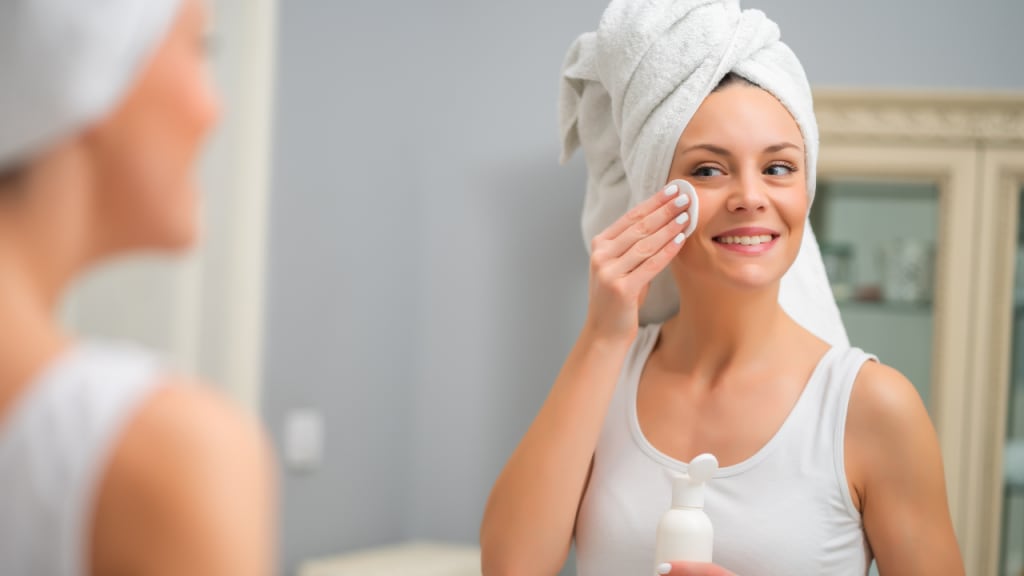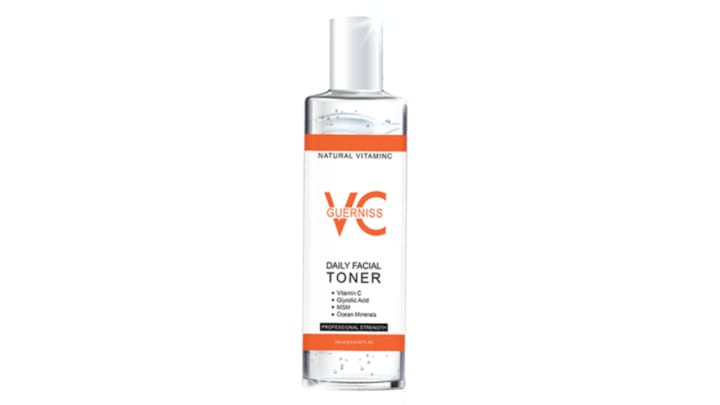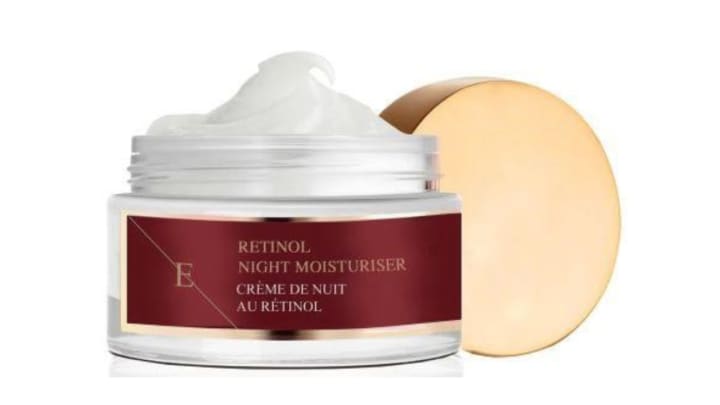
Having decent skin-care products isn't enough. You must also apply your items in the precise order for them to be effective. Establishing a good skin care routine sequence is critical for recognizing your skin care issues and how to effectively deal with them while utilizing the appropriate skin care products. Your regimen will be determined by your skin type, product components and formulations, and time of day. Aside from application sequence, some experts say it's also crucial to consider how long it takes your skin to absorb your products.
A Step-by-Step Guide to Day time Skin Care Routine
The morning ritual is all about protecting yourself from the sun, pollutants, and so on.
1st Step: Use a Cleanser
Begin your daily routine by spraying warm water on your face and washing it with a mild face cleanser suitable for your skin type.
- Oily skin: A foamy or gel cleanser will remove extra debris and oil from your skin. Look for substances that can help control and eliminate excess oil, like niacinamide and salicylic acid. You can try Simple Anti-Bac Kind Defense Cleansing Wash or Noir Dreamy Glow Brightening Cleansing Foam, both of which contain Niacinamide and will aid in oil removal.
- Acne-prone skin: Acne-prone skin should use a mild foamy cleanser containing acne-fighting chemicals such as salicylic acid, glycolic acid, benzoyl peroxide, or sulfur. Neutrogena Oil-Free Acne Wash includes salicylic acid and is dermatologically indicated for acne-prone skin.
- Dry Skin: If you have dry skin, look for a solution that has moisturizing elements such as ceramides, glycerin, hyaluronic acid, and botanical oils. Boots Cucumber Facial Wash, Cetaphil Gentle Skin Cleanser, CeraVe SA Smoothing Cleanser, and more are examples.

- Sensitive skin: Use a mild cleanser that traps pollutants and lifts them away without drying your skin. Cetaphil Gentle Foaming Cleanser and Simple Hydrating Light Moisturizer are scent and soap free, and they wash without drying out your skin. So, if you have sensitive skin, you should try it.
2nd Step: Apply Toner
Toners were developed to assist restore the skin's pH after it had become overly basic due to the use of harsh soaps. Each type of toner is designed to address a specific skin ailment, so be sure you use the proper one for you.
If you have acne-prone skin, search for a toner that contains hydroxy acids such as salicylic acid and lactic acid, which promote cell turnover (Neutrogena Hydro Boost Clear Lotion, DermDoc 2% salicylic Acid Face Toner).
Look for a moisturizing toner that is free of alcohol and has ingredients like glycerin and hyaluronic acid to relieve dry or sensitive skin (Guerniss Anti Melasma Toner).
Look for mild exfoliants, hydration enhancers, and antioxidants like vitamin C, vitamin E, and green tea for combination skin, since they can battle free radicals and prevent skin damage (The Body Shop Tea Tree Anti-Imperfection Daily Solution).
Look for astringents that constrict pores, such as alcohols or witch hazel, if you have oily skin (Guerniss VC Daily Facial Toner)

3rd Step: Apply Serum
Serums are highly concentrated, nutrient-dense therapies that target specific issues, so keep them as near to the skin as possible.
Dermatologists advocate antioxidant serums, which have a number of advantages ranging from reducing inflammation to neutralizing UV radiation and environmental contaminants. An antioxidant serum that prevents the generation of free radicals and slows the aging process. And vitamin C ( POSTQUAM Facial Biological Serum with Hyaluronic Acid, TALIKA Hydrating Serum, Guerniss VC Serum N85, TALIKA Hydrating Serum) is the gold standard antioxidant serum.
4th Step: Spot Treatment
Spot treatments differ from moisturizers, serums, and essences in that they are intended to be applied just on problem areas as needed. Dark spot treatments are an exception, since they may typically be used on a daily basis to augment your usual skincare regimen. When using a spot treatment, apply it to thoroughly washed skin, ideally before applying any additional treatments such as moisturizers or sunscreen (Guerniss Anti Melasma Whitening Serum, WARDA Skin Glow Boost Vitamin C Facial Moisturizer).
5th Step: Apply Moisturizer
Despite the fact that your body has its own natural lubricating system comprised of glands that secrete oil (or sebum) to maintain a protective coating against harsh outside conditions and infections, most of us require additional hydration after the havoc that sun, weather, and harsh chemicals wreak on our skin.
Here's how to choose a moisturizer formula for your skin type:
- Dry skin: A thick cream containing emollients, humectants, ceramides, and occlusives (Elizabeth Arden Visible Difference Replenishing HydraGel Complex, DR EVE RYOUTH Vitamin C + Hyaluronic Acid Hydrabright Day Moisturizer).
- Oily or acne-prone skin: Look for non-comedogenic or oil-free lotions or gel-based products. (Oil-Free Acne Pink Grapefruit Face Lightweight Moisturizer by Neutrogena)
- Sensitive skin: Look for hypoallergenic solutions that are devoid of possible irritants such as scent and alcohol. (Simple Vital Vitamin SPF 15 Cream)
6th Step: Apply Sunscreen
To be effective, synthetic sunscreens must be absorbed into the skin, thus using it after your moisturizer can delay and hamper this process. However, if you use your synthetic sunscreen first, your moisturizer will not perform as effectively since the skin is coated with synthetic sunscreen (Missha All Around Safe Block Sun Milk Ex Essence SPF 50+, Missha All Around Safe Block Sun Cotton SPF 50+, Missha All Around Safe Block Aqua Sun SPF 50+).

Some SPF formulations contain both synthetic and natural components. Dermatologists often prescribe mineral and pure zinc-oxide sunscreens for sensitive skin (however many mineral sunscreens did not cause irritation in GH Beauty Lab testing); for oily skin, search for non-comedogenic, oil-free gel compositions (Cerave Hydrating Mineral Sunscreen SPF 50). Avoid sunscreens that contain alcohol if you have dry skin. People with darker skin tones may prefer synthetic sunscreens to avoid the white cast of some physical formulae, however, firms have begun to offer mineral formulations that are not chalky.
A Step-by-Step Guide to Night time Skin Care Routine
Because your skin regenerates and repairs itself as you sleep, your bedtime regimen is ideal for ensuring that your skin receives as many nutrients and active substances as possible.
1st Step: Use a Cleanser
First, wash away the day's makeup and grime. Try double cleansing, which is first removing your makeup with a cleansing oil and then washing your face with your normal cleanser. You may use Boots Rose Facial Wash to remove both makeup and grime. As a night cleanser, use a vitamin C-containing face wash or cleanser (Guerniss Paris VC Amino Acid Deep Cleansing Bubbles Face Wash). If you have acne-prone skin, keep using the day facewash.
2nd Step: Apply Essences, and Toners
If you use a toner, use it the same way you would in the morning.
Some people like to layer several sorts of skin care boosters at night, such as mist, essences, and beauty waters (SIODIL Moisturizing Mist). These are infused with various active substances, but the main goal is to hydrate and nourish the skin.
3rd Step: Treatments and Serums
Skin, like the rest of the body, does much of its mending, restoring, and rebuilding when we sleep. Most targeted skin care treatments, such as prescription medications (tretinoin, acne and rosacea creams), retinol creams, exfoliating treatments, and anti-aging serums (loaded with peptides, growth factors, and other biologically active components), are best used at night. Alternate between retinoid and the spot-fading active component hydroquinone while treating hyperpigmentation (DOCTORS COSMECEUTICAL Retinol Serum, ECLAT SKIN Retinol Serum, POSTQUAM Retinol A Age Control Serum)
If you have a blemish (or several), use an acne treatment right now (SIODIL Anti Acne Serum). Be proactive rather than reactive when it comes to persistent breakouts.
4th Step: Apply Night Cream or Moisturizer
If you have aged, wrinkled, or dehydrated skin, you should use night creams that contain anti-aging, anti-wrinkle, and hydration ingredients (Mighty Green Anti-Ageing CBD Face Cream, Elizabeth Arden Visible Difference Replenishing Hydragel Complex, Lancior Paris Youth Precious Night Remodel Cream, Lancior Paris Pearl Radiance Detox Night Cream).

Moisturizer forms a barrier that locks in the skin's natural hydration as well as any active substances to combat moisture loss while sleeping. Retinoids (vitamin A derivatives such as retinol) can reduce dark spots, breakouts, and fine lines by increasing skin-cell turnover, but they can also be irritating, especially for sensitive skin (Dr Eve Ryouth Vitamin D + Hyaluronic Acid Pro Age Night Moisturizer, Eclat Skin Retinol Night Moisturizer).

Great skin isn't only a question of genetics; your everyday activities have a significant influence on what you see in the mirror. Finally, skin care is a matter of personal preference. We have provided you with a short guide on skin care. If you are unsure about what, how, or when to use anything, seek advice from an expert.






Comments
There are no comments for this story
Be the first to respond and start the conversation.